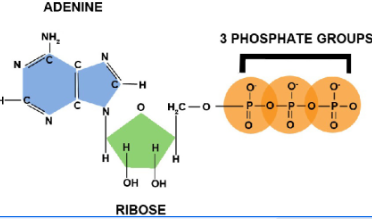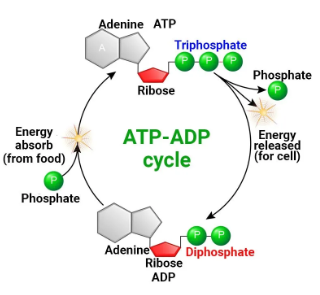IB Bio HL Unit 5
1/140
There's no tags or description
Looks like no tags are added yet.
Name | Mastery | Learn | Test | Matching | Spaced |
|---|
No study sessions yet.
141 Terms
ATP
The molecule that serves as the energy currency of the cell
ATP monomer
a modified nucleotide
Production of ATP
mitochondria, aerobic cellular respiration
Processes where ATP is used
active transport, anabolic reactions, muscle contractions, cellular movement
ATP structure
1 adenine, 1 ribose sugar, 3 negatively charged phosphate groups

ATP Hydrolysis
energy is released when the 3rd phosphate is broken off due to the bonds between the 2nd and 3rd phosphate bonds breaking
ADP
Adenosine diphosphate
ADP phosphorylation
adding a phosphate group to ADP, requires energy from the breakdown of food molecules (like glucose) through cellular respiration
Diagram of ATP-ADP cycle
ATP loses a phosphate due to hydrolysis (exergonic) and turns into ADP. ADP gains a phosphate from phosphorylation (endergonic) and turns back into ATP.

Photosynthesis
transforming light energy from the sun into chemical energy (organic molecules)
Photosynthesis equation
6CO2 + 12H2O —> C6H12O6 +6O2 + 6H2O

autotroph
organisms that can produce their own chemical energy (organic compounds). also called producers
phototroph
autotrophs that use light to produce organic compounds (aka photosynthesis)
Producers (autotrophs)
source of energy in ecosystems
3 examples of photosynthetic organisms
Plants, algae, cyanobacteria
location of photosynthesis in plants
mesophyll cells in leaves
endosymbiosis
why chloroplasts have two membranes, organelle was engulfed by eukaryotic cell
thykaloid
flattened, membrane bound sacs (high sa:v ratio)
thykaloid membrane
outer part of thykaloid
thykaloid space
inner region of thykaloid
function of thykaloids
light-reaction, contains chlorophyll embedded in membrane
granum (pl: grana)
stack-like arrangement of thykaloids in chloroplast to maximize light absorption
stroma
fluid filled space between inner membrane and thykaloid membrane
stroma function
contain enzymes and materials for Calvin cycle, also location of Calvin cycle
3 spaces in a chloroplast
intermembrane space (between inner and outer membrane), stroma(between inner membrane and thykaloid membrane, thykaloid space (within thykaloid membrane)
lamellae
bridge-like structure that connects grana
diagram of chloroplast
[image]
![<p>[image]</p>](https://knowt-user-attachments.s3.amazonaws.com/1dd7fcd1-22bb-41de-a27e-21c4081f2fee.png)
wavelength-color of light relation
visible light is a part of the electromagnetic spectrum
pigment
molecules that absorb light
pigment vs wavelength
pigments ABSORB light, wavelengths REFLECT light
3 pigments in plants
Chlorophyll, xanthophyll, carotenoids.
major photosynthetic pigment
chlorophyll
chlorophyll and chloroplasts
chlorophyll reflects green light and absorbs all other colors. this makes chloroplasts green.
absorption spectrum
a graph measuring the different wavelengths of light absorbed by a particular substance or pigment. each line represents one pigment
light absorption and photosynthesis
plants have several different types of pigments, so overall rate of photosynthesis is a result of a combination of ALL pigments absorbing light
action graph
a graph that represents the effectiveness of different wavelengths of light on photosynthesis
difference between action and absorption graphs
absorption spectrum measures 1 pigment, action spectrum measures all pigments
paper chromatography
a lab technique used to separate mixtures of substances as they move up the paper
how pigments are separated during paper chromeotography
pigments dissolve in the solvent and will separate based on solubility. the more soluble the pigment is, the further it travels
Retention factor Rf
ratio of distance moved by a pigment to the distance moved by the solvent, in mm.
formula for Rf
distance of pigment/distance of solvent (in mm)
Calvin Cycle location
Occurs in the stroma
Calvin Cycle desc.
uses ATP and NADPH from light reaction
Calvin Cycle input/output
input is CO2, output is sugar (glucose)
light reaction location
occurs in thylakoids
light reaction desc.
utilizes photosynthetic pigments to absorb light
light reaction input/output
splits H2O and produces O2 as a byproduct, creates ATP and NAPDH for CC. CC gives light reaction ADP and NADP+
light reaction/CC relation
light reaction creates ATP and NAPDH for CC. CC gives light reaction ADP and NADP+
reduction reaction
gaining electrons/negative charges (Reduction Is Gain)
oxidation reaction
losing electrons (Oxidation Is Loss)
photosystems
integral proteins complexes within the phospholipid bilayer
photosystem location
thylakoid if eukaryotic, cyanobacteria if prokaryotic
process of photoactivation in photosystems
photons strike pigment molecules, which excites electrons. the electrons are transferred between an array of pigments before they reach a reaction centre, where they are emitted from the photosystem. OXIDATION REACTION
difference between photosynthesis I and II
PS II comes before PS I. PS II is attracted to a lower wavelength than PS I.
electron transfer chain (ETC)
where electrons go after leaving the reaction centre, part of PS II
photolysis
the process of using light energy to break water molecules in order to replace missing electrons in PS II
equation for photolysis
2H2O →4H+ + O2 +4e-
photolysis location
thylakoid space by PS II
what happens to protons (H+ ) in photolysis
remain in thylakoid space and begin to build concentration gradient
what happens to O2 in photolysis?
diffuses out of the chloroplast and into the atmosphere
what happens to electrons (e-) in photolysis?
transferred from water to PS II
structure of first ETC
a series of integral protein complexes within a thylakoid membrane
functions of 1st ETC
transfers electrons from PS II to PS I, harnesses extra energy from electrons to pump protons into thylakoid space. establishes a high concentration gradient (active transport)
3 ways protons are concentrated inside a thylakoid
1) protons produced in thylakoid during photosynthesis, 2) protons are pumped into thylakoid by ETC proton pump, 3)thylakoids are small spaces so protons accumulate quickly. ALL of this allows for facilitated diffusion of protons OUT of thylakoid.
proton gradient function
allows for passive transport of protons OUT of thylakoid (down concentration gradient). MUST be used for facilitated diffusion
chemiosmosis
the diffusion of H+ down its concentration gradient through ATP synthase (facilitated diffusion)
ATP synthase
a transmembrane integral proteins that performs ADP phosphorylation to create/synthesize ATP
ATP synthesis through chemiosmosis
As the H+ diffuses through ATP synthase, it causes the enzyme to turn providing energy needed to phosphorylate ADP into ATP
photophosphorylation
using photosynthesis to turn ADP into ATP
destination for ATP in light reaction
ATP will go to power the Calvin cycle
process in photosystem I
photoactivation occurs in PS I
destination of excited electrons after leaving PS I
protons go to reaction centre, then transferred to NADP+ Reductase
replacement of missing electrons in PS I
electrons from PS II via first ETC will replace missing electrons from PS I
NADPH function
electron carrier enzyme, reduced form
NADP+
electron carrier enzyme, oxidized form
NADP+ reduction process
electrons leave PS I and transferred to NADP+ Reductase, where they will combine electrons to form NADPH. occurs on stroma side of thylakoid membrane
destination of NADPH in light reaction
NADPH (full of electrons) will go to the Calvin Cycle to drop off electrons
flow of electrons in non-cyclic photophosphorylation
electrons flow from water →PS II →1st ETC →PS I →NADPH
flow of electrons during cyclic photophosphorylation
sometimes electrons from PS I go back to 1st ETC by accident, but ATP is still made normally in ETC
3 phases of Calvin Cycle
carbon fixation, reduction, regeneration
carbon fixation
attacing a CO2 to a Ribulose biphosphate (RuBP)
RuBisCO
enzyme that performs the carbon fixation process
rubisco characteristics
slow enzyme, non-efficient, high energy requirement for CC
photorespiration
adding an O2 instead of CO2, making rubisco less efficient b/c molecule cannot continue through CC
rubisco CO2 concentration
rubisco works best at a high CO2 concentration to reduce the chance O2 is accidentally added to RuBP
event after initial carbon fixation
each of the resulting 6-carbon compounds breaks into 2×3 carbon compounds called glycerate 3-phosphate (GP)
reduction phase
GP molecules converted into trioses phosphate (aka glyceraldehyde 3-phosphate G3P)
inputs of reduction phase
6 GP, 6 ATP, 6 NADPH
outputs of reduction phase
6 TP/G3P, 6 ADP, 6 NADP+
reduced molecule in reduction phase
GP gains electrons to become TP
molecules exiting CC after reduction phase
1 TP exits cycle (5 remain)
regeneration
5 TPs remaining in cycle (15 carbon atoms) are rearranged into 3 RuBP. requires energy from 3 ATP (creates ADP)
inputs of regeneration
5xG3P/TP, 3xATP
outputs of regeneration
3xRuBP
“regeneration” in regenerating phase
CO2 receptor is recreated, allowing for CC to continue
glucose formation in Calvin cycle
TP is turned into glucose 5 G3P
molecules made from CC outputs
carbs, amino acids, nucleotides
light dependent reaction
alternate name for light reaction b/c it is dependent on light, but light is not the only thing needed
light independent reaction
alternate name for CC, but CC relies on ATP/NADPH from light reaction
cellular/aerobic respiration
utilizing oxygen when breaking down organic molecules, occurs in mitochondria